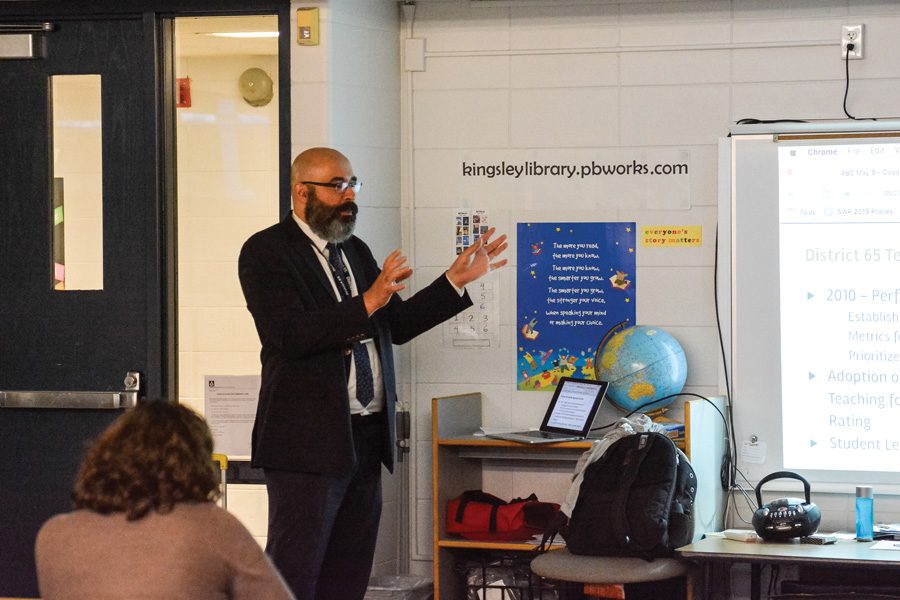Kingsley parents, district officials point to teacher evaluation system to address racial achievement gap
Brian Meng/Daily Senior Staffer
District 65 Assistant Superintendent of Schools Andalib Khelghati speaks at Kingsley Elementary School. Khelghati said he is confident that the achievement gap between Black, Latinx students and white students can be narrowed.
May 10, 2019
In response to multiple metrics that indicate lower achievement levels among black and Latinx students in Evanston/Skokie School District 65, parents are pointing toward flaws in teacher and principal evaluation techniques.
Despite better-than-average teacher evaluations, the racial achievement gap has widened in recent years. Parents and district officials pointed to a evaluation system partly controlled by teachers, which doesn’t mandate that they be evaluated on the achievement of students of color.
In 2015, 54 percent of white students in District 65 met English and Language Arts benchmarks on the PARCC test, while 28 and 27 percent of black and Latinx students respectively met those same standards. In 2018, those numbers decreased, with 15 percent of black students and 20 percent of Latinx students meeting ELA benchmarks.
“Our teachers are flying high, but our kids aren’t even in the air yet,” said LaTarsha Green, District 65’s executive director of black student success.
The D65 African-American, Black, and Caribbean Parent Community and Evanston Collective hosted the seminar at Kingsley Elementary School Thursday, which sought to better equip parents of students in underperforming groups with information on how teacher and principal evaluations can be useful in facilitating growth in student learning, especially in narrowing the learning gap between racial groups.
Andalib Khelghati, assistant superintendent of schools for District 65, said he has the “utmost confidence” that changing the trajectory of Black and Latinx scores can and will be achieved.
“It’s not a new challenge,” Khelghati said, “but it’s an opportunity that we truly believe we can work towards and overcome.”
However, many parents remain skeptical that statewide teacher evaluation guidelines do enough to encourage teachers to focus on improving learning outcomes for low-scoring groups.
As a result of the 2010 Performance Evaluation Reform Act, the district established a joint evaluation committee comprised of teachers and district leaders to assess teachers. They base their scores the Charlotte Danielson Framework for Teaching, a rubric for evaluating teachers.
In their evaluation, every teacher is required to identify underperformance in one subject area, choose a minimum of 10 students to assess, and measure their growth, which makes up 30 percent of the overall evaluation. District 65 uses the MAP test, which students between third and eighth grade are required to take three times throughout each school year, to measure student growth.
But teachers are also allowed to substitute another committee-approved measure in their evaluation.
Teachers are not only expected to identify the top performers of the class, but also evaluate a group in need of improvement in a specific subject area. However, there’s no guarantee Black and Latinx students are included in their samples. This mismatch is shown by inconsistencies between scores received by teachers, and the salient gaps between the scores of white and non-white students.
Green said the wide racial disparities in learning outcomes call for closer evaluation of instruction in classrooms, which is the closest indicator for learning performance.
“We want to see which teachers are teaching really well, and which teachers are really struggling,” Green said.
Illinois evaluates teachers using four scores: unsatisfactory, basic, proficient and distinguished. In the state of Illinois, 97 percent of teachers are rated proficient and distinguished, and in District 65, that number is 99 percent.
Alyce Barry, of the Evanston branch of the Organization for Positive Action and Leadership, said in the face of considerable gaps in learning outcomes, the education processes in District 65 needs “something radically different.”
“For a parent who’s got a little one,” Barry said, “they know their child is going to go through the district and going to get basically less than half the education that a white child of that age would get, and it’s just so not fair.”
Bobby Burns, meeting facilitator for the D65 African-American, Black, and Caribbean Parent Community and a parent at Dawes Elementary School, said he hopes these working groups of parents can help identify policies that need correcting, and advocate for change from the ground up.
One of the objectives of Thursday’s meeting was to give parents the tools and language to help them ask meaningful questions and improve the academic experiences of their children, Burma said.
“How much are teacher evaluations based on outcomes of black students in the district?” Burma said. “That was the question I wanted the answer to today. The answer is that it’s not a significant part of their evaluation.”
Email: [email protected]
Related Stories:
– Black students in several grades do not meet college benchmark readiness at King Arts School
– King Arts Parents demand partnership with District 65 Officials for equitable education


